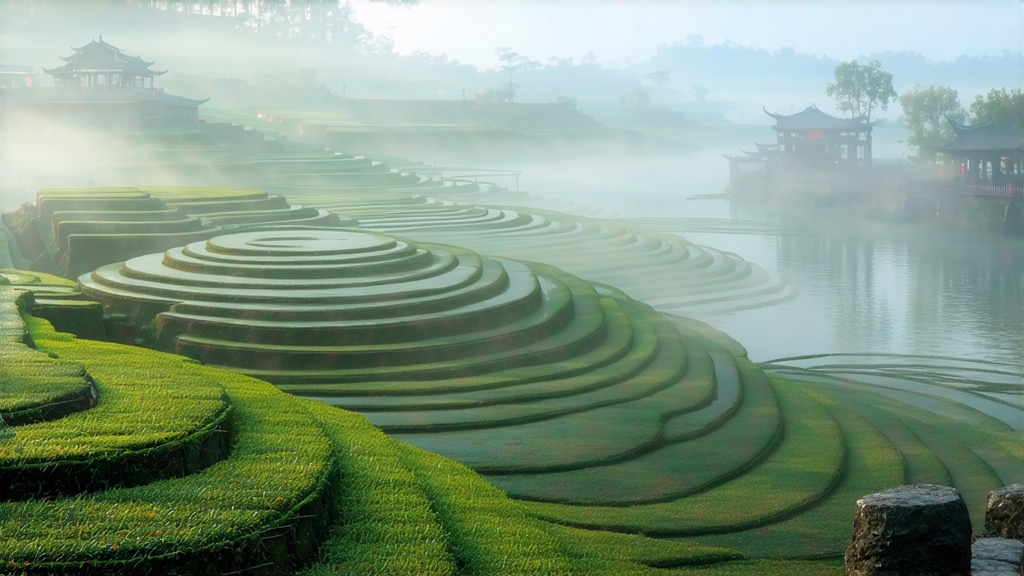
Biluochun, whose name translates literally to “Green Snail Spring,” is one of China’s ten most celebrated teas, yet it remains a quiet mystery to many outside the Middle Kingdom. Produced exclusively in the fog-laced hills that cradle Dongting Lake in Jiangsu Province, this tea is prized for its improbably tiny, spiral-shaped leaves and a fragrance so intense that, when first exported to Europe in the eighteenth century, customs officers reportedly catalogued it as “Chinese flower water.” To understand Biluochun is to step into a microclimate where lake mist, fruit trees and tea bushes conspire each April to create a cup that tastes like liquid spring.
History: From Xiaoshi’s Accident to Imperial Tribute
Local chronicles credit a tea-picker named Xiaoshi who, in 1675, accidentally packed fresh leaves too tightly into her bamboo basket while hurrying down the mountain. Overnight the bruised leaves curled into tight spirals and exuded an unexpected orchid aroma. The village headman brewed the accidental batch, declared it superior, and presented it to the Kangxi Emperor. The Qing court was so enamored that the emperor renamed the tea “Biluochun” during his southern inspection tour of 1699, noting its jade coils resembled tiny snails and its fragrance rivaled that of spring itself. For the next two centuries only leaves plucked within a five-kilometer radius of Dongting’s two peaks—Dongshan and Xishan—were accepted as tribute, transported by imperial barge along the Grand Canal to Beijing within seven days of harvest.
Terroir: Lake, Mist and Apricot Blossoms
Dongting Lake is a large, shallow freshwater body that stores daytime heat and releases it as night-time mist. The mist filters sunlight, increasing chlorophyll while slowing photosynthesis, which elevates amino acids—especially L-theanine—responsible for sweetness and umami. Around the terraces, fruit growers plant peach, plum and apricot trees; their roots share mycorrhizal fungi with tea bushes, and their blossoms shower petals onto the leaf surface, contributing subtle floral notes that chemists have traced to shared volatile esters. Soil is a sandy loam rich in magnesium and poor in calcium, encouraging tender bud growth. The result is a leaf that is 30 % smaller than Dragon Well, yet contains 50 % more aromatic compounds per gram.
Cultivars: Two Clones and One Wild Struggle
Although more than a dozen local strains exist, only two are legally permitted to be sold under the “Original Biluochun” geographical indication:
- Dongting Small-Leaf #1—an heirloom cultivar with downy buds that tolerates lake humidity and produces the classic orchid note.
- Fuding White #9 grafted onto Dongting rootstock—introduced in 1986 to increase yield while retaining fragrance; it yields a paler liquor and lighter body.
A third strain, the so-called “Wild Curl,” grows semi-feral on cliff edges. Its leaves are thicker, bitterer, and prized by aging masters for charcoal finishing, but annual production is under 80 kg and rarely leaves the province.
Harvest Calendar: One Leaf, One Bud, One Hour
Authentic Biluochun is made only between Qingming (early April) and Grain Rain (late April). Pickers rise at 4:30 a.m. to climb the misty slopes before sunrise, selecting the standard “one leaf and one unfolded bud” measuring 1.5–2.0 cm. Leaves must reach the village workshop within one hour; otherwise the delicate cell walls oxidize and lose the signature spiral. A master picker can harvest 600 g of fresh leaf per hour—enough for only 120 g of finished tea—explaining why top-grade Spring Pre-Qingming Biluochun retails above US $1,000 per 100 g.
Craft: The Five Motions of the Spiral
Unlike flat-pressed Dragon Well or basket-fired Gunpowder, Biluochun is shaped entirely by hand on a 180 °C iron pan. The process, unchanged since Kangxi’s era, consists of five motions repeated for 35–40 minutes:
- Kill-green (shaqing): 200 g of fresh leaf are tossed for 3 minutes to deactivate enzymes.
- Initial roll: leaves are pushed against the pan in a clockwise arc to break surface cells.
- Curl & tug: the master cups both palms, lifting and dropping the mass to form loose spirals.
- Snap & twist: thumb